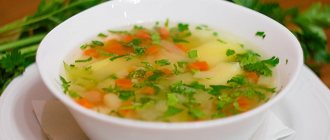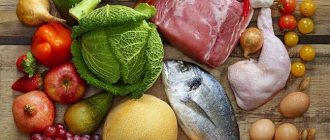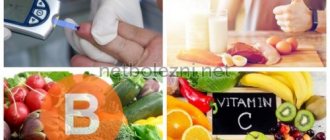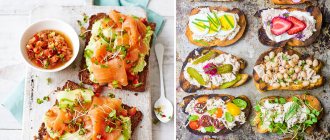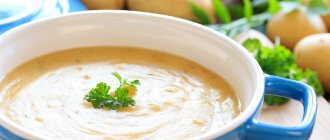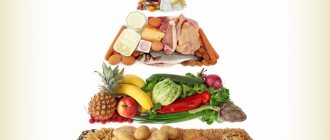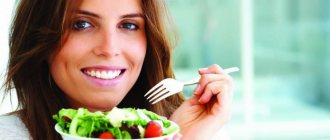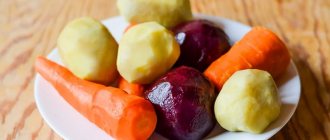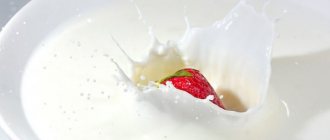The fifteenth diet is a balanced, healthy, complete diet. The diet belongs to a number of therapeutic nutrition systems developed by the Soviet scientist Manuil Pevzner. Using simple rules and requirements, this technique speeds up recovery from illness, improves immunity in adults and children, and normalizes weight. From time to time it is recommended even to healthy people for the prevention of diseases of the gastrointestinal tract, liver, kidneys, and heart.
General rules
Diet No. 15, Table No. 15 according to Pevzner is prescribed for diseases that do not require special therapeutic nutrition in the absence of disorders of the digestive system.
This is a transitional diet from any therapeutic to regular nutrition during the recovery period. Refers to physiologically complete nutrition in a hospital setting and corresponds to nutritional standards for a person who does not engage in physical labor. It is also called the general diet.
It contains a sufficient amount of nutrients, minerals and an increased amount of vitamins . The diet does not provide for any sparing of the gastrointestinal mucosa; the range of products is varied. Dishes have a variety of heat treatments (even frying).
Chemical composition: 90-95 g of proteins (half of animal origin), 100 g of fat (one third of vegetable origin), 350-400 g of carbohydrates. Energy value - 2600-2700 kcal. Salt is allowed in the amount of 12 g, and liquid - 1.5-2 liters. Diet plays an important role. You should not allow long breaks and eat food at least 4 times (more is possible when organizing light snacks). Fractional meals at certain hours contribute to the rhythmic activity of the gastrointestinal tract.
General characteristics of dietary table No. 15
Diet No. 15 fully satisfies a person’s physiological needs for nutrients and energy. The calorie content of the diet is normal. In terms of the composition of products and methods of preparation, diet No. 15 is closest to the rational diet of healthy people. The diet involves limiting spicy foods and seasonings, refractory animal fats (fatty meat, lard) and cooking fats. When prescribing a diet for patients with diseases of the nervous system, tonic and stimulating foods (coffee, strong tea, alcoholic drinks, chocolate, cocoa) are excluded. For hypertension stages I and IIA, dishes of this diet are prepared without salt, dispensing salt into the patient’s hands in the amount of 4–6 g per day. Food is prepared in almost any form, the temperature of the dishes is normal. Diet No. 15 involves split meals 4–6 times a day.
Authorized Products
Dietary Table number 15 includes:
- Wheat and rye bread, any flour products.
- It is better to cook soups with weak and non-greasy broths. This can be borscht, cabbage soup, rassolnik, beetroot soup, vegetable, cereal and mushroom soups, as well as dairy soups.
- Any fish and different culinary preparations.
- Low-fat meat and poultry are prepared in any way. Boiled sausages, frankfurters, and small sausages are allowed.
- Fermented milk drinks (yogurt, kefir, yogurt, acidophilus) are required in the diet.
- It is necessary to include milk, cottage cheese, cheese, sour cream (it is added to dishes) daily.
- Eggs in any preparation.
- Various cereals, pasta and legumes if well tolerated.
- Butter, ghee, vegetable oils.
- Any vegetables (limited to radishes, radishes), greens.
- Fresh fruits and berries, raw and after heat treatment (purees, mousses, jellies), fresh juices, compotes, jelly, fruit drinks.
- Recommended drinks include: cocoa, tea, coffee, rosehip infusion and wheat bran decoction.
- Sugar, jam, jam, honey, ice cream, marmalade are allowed.
Table of permitted products
| Proteins, g | Fats, g | Carbohydrates, g | Calories, kcal | |
Vegetables and greens | ||||
| zucchini | 0,6 | 0,3 | 4,6 | 24 |
| cabbage | 1,8 | 0,1 | 4,7 | 27 |
| cauliflower | 2,5 | 0,3 | 5,4 | 30 |
| carrot | 1,3 | 0,1 | 6,9 | 32 |
| cucumbers | 0,8 | 0,1 | 2,8 | 15 |
| beet | 1,5 | 0,1 | 8,8 | 40 |
| pumpkin | 1,3 | 0,3 | 7,7 | 28 |
Fruits | ||||
| apricots | 0,9 | 0,1 | 10,8 | 41 |
| oranges | 0,9 | 0,2 | 8,1 | 36 |
| watermelon | 0,6 | 0,1 | 5,8 | 25 |
| bananas | 1,5 | 0,2 | 21,8 | 95 |
| pears | 0,4 | 0,3 | 10,9 | 42 |
| melon | 0,6 | 0,3 | 7,4 | 33 |
| lime | 0,9 | 0,1 | 3,0 | 16 |
| lemons | 0,9 | 0,1 | 3,0 | 16 |
| tangerines | 0,8 | 0,2 | 7,5 | 33 |
| plums | 0,8 | 0,3 | 9,6 | 42 |
| apples | 0,4 | 0,4 | 9,8 | 47 |
Berries | ||||
| grape | 0,6 | 0,2 | 16,8 | 65 |
| strawberry | 0,8 | 0,4 | 7,5 | 41 |
| sea buckthorn | 1,2 | 5,4 | 5,7 | 82 |
| currant | 1,0 | 0,4 | 7,5 | 43 |
| rose hip | 1,6 | 0,0 | 14,0 | 51 |
Mushrooms | ||||
| mushrooms | 3,5 | 2,0 | 2,5 | 30 |
Nuts and dried fruits | ||||
| raisin | 2,9 | 0,6 | 66,0 | 264 |
| dates | 2,5 | 0,5 | 69,2 | 274 |
Cereals and porridges | ||||
| buckwheat (kernel) | 12,6 | 3,3 | 62,1 | 313 |
| cereals | 11,9 | 7,2 | 69,3 | 366 |
| corn grits | 8,3 | 1,2 | 75,0 | 337 |
| pearl barley | 9,3 | 1,1 | 73,7 | 320 |
| millet cereal | 11,5 | 3,3 | 69,3 | 348 |
| white rice | 6,7 | 0,7 | 78,9 | 344 |
| barley grits | 10,4 | 1,3 | 66,3 | 324 |
Bakery products | ||||
| bagels | 16,0 | 1,0 | 70,0 | 336 |
| buns | 7,2 | 6,2 | 51,0 | 317 |
| butter horns | 8,3 | 12,1 | 50,5 | 345 |
| drying poppy seeds | 11,3 | 4,4 | 70,5 | 372 |
| wheat bread | 8,1 | 1,0 | 48,8 | 242 |
| rye-wheat bread | 8,1 | 3,4 | 42,2 | 222 |
| Rye bread | 6,6 | 1,2 | 34,2 | 165 |
Confectionery | ||||
| jam | 0,3 | 0,2 | 63,0 | 263 |
| jam | 0,3 | 0,1 | 56,0 | 238 |
| jelly | 2,7 | 0,0 | 17,9 | 79 |
| fruit and berry marmalade | 0,4 | 0,0 | 76,6 | 293 |
| Kurabye cookies | 6,7 | 25,8 | 64,6 | 516 |
| oatmeal cookies | 6,5 | 14,4 | 71,8 | 437 |
| cake | 3,8 | 22,6 | 47,0 | 397 |
Raw materials and seasonings | ||||
| honey | 0,8 | 0,0 | 81,5 | 329 |
| sugar | 0,0 | 0,0 | 99,7 | 398 |
| milk sauce | 2,0 | 7,1 | 5,2 | 84 |
| sour cream sauce | 1,9 | 5,7 | 5,2 | 78 |
Dairy | ||||
| milk | 3,2 | 3,6 | 4,8 | 64 |
| kefir | 3,4 | 2,0 | 4,7 | 51 |
| cream | 2,8 | 20,0 | 3,7 | 205 |
| sour cream | 2,8 | 20,0 | 3,2 | 206 |
| curdled milk | 2,9 | 2,5 | 4,1 | 53 |
| acidophilus | 2,8 | 3,2 | 3,8 | 57 |
| yogurt | 4,3 | 2,0 | 6,2 | 60 |
Cheeses and cottage cheese | ||||
| cheese | 24,1 | 29,5 | 0,3 | 363 |
| cottage cheese | 17,2 | 5,0 | 1,8 | 121 |
Meat products | ||||
| beef | 18,9 | 19,4 | 0,0 | 187 |
| veal | 19,7 | 1,2 | 0,0 | 90 |
| rabbit | 21,0 | 8,0 | 0,0 | 156 |
Bird | ||||
| chicken | 16,0 | 14,0 | 0,0 | 190 |
| turkey | 19,2 | 0,7 | 0,0 | 84 |
Eggs | ||||
| chicken eggs | 12,7 | 10,9 | 0,7 | 157 |
Fish and seafood | ||||
| Red caviar | 32,0 | 15,0 | 0,0 | 263 |
| black caviar | 28,0 | 9,7 | 0,0 | 203 |
| canned fish | 17,5 | 2,0 | 0,0 | 88 |
Oils and fats | ||||
| butter | 0,5 | 82,5 | 0,8 | 748 |
| corn oil | 0,0 | 99,9 | 0,0 | 899 |
| olive oil | 0,0 | 99,8 | 0,0 | 898 |
| sunflower oil | 0,0 | 99,9 | 0,0 | 899 |
| ghee | 0,2 | 99,0 | 0,0 | 892 |
Non-alcoholic drinks | ||||
| mineral water | 0,0 | 0,0 | 0,0 | — |
| lingonberry juice | 0,1 | 0,0 | 10,7 | 41 |
| green tea | 0,0 | 0,0 | 0,0 | — |
| black tea | 20,0 | 5,1 | 6,9 | 152 |
Juices and compotes | ||||
| compote | 0,5 | 0,0 | 19,5 | 81 |
| apricot juice | 0,9 | 0,1 | 9,0 | 38 |
| jelly | 0,2 | 0,0 | 16,7 | 68 |
| carrot juice | 1,1 | 0,1 | 6,4 | 28 |
| tomato juice | 1,1 | 0,2 | 3,8 | 21 |
| pumpkin juice | 0,0 | 0,0 | 9,0 | 38 |
| * data is per 100 g of product | ||||
Products for diet
The diet should be rich in natural, healthy foods. You should give up all synthetic foods, flavorings, dyes, and fast food. Be sure to eat vegetable dishes, fruits, herbs, and berries once or twice a day. Meat and fish products should be chosen of low-fat types and varieties; they should be consumed without skin, fascia, or tendons.
It is recommended to include in your diet:
- Bran, oat, rye bread. White bread can be used, but in small quantities. It is better to eat yesterday's baked goods, dry cookies, biscuits, gingerbread cookies, dried bread, and toast.
- Lean meat and offal. Recommended meat is rabbit, turkey, chicken, pure beef and veal fillet. By-products can be used two to three times a week.
- Lean fish and seafood. All types of shellfish, river and sea fish are suitable. It is important to carefully select these products and avoid spoiled ingredients, fish from contaminated waters, and canned goods with damaged packaging.
- Vegetables and greens. They can be eaten raw in the form of salads or slices, or can be cooked. Greens should be used fresh, with dense leaves.
- Fruits and berries. It is recommended to consume them before lunch, and leave vegetables and protein foods for the second half of the day. It is better to choose sweet and sour varieties and types: pears, grapes, apples, raspberries, currants. Berries and fruits can be eaten whole or made into drinks and desserts.
- Porridge and pasta. All types of cereals are allowed. Pasta and legumes can be included in the diet up to 3 times a week.
- Dairy products. It is better to choose low-fat products, without flavoring additives and dyes. You can use cottage cheese, hard mild cheese, fermented milk drinks. The amount of whole milk should be reduced; you can drink no more than a glass a day; you can add it to dishes or drinks.
- Vegetable oils. Any type of cold-pressed oil is suitable: flaxseed, olive, sunflower, sesame. You can add citrus juice and apple cider vinegar to salad dressings. A small amount of butter is allowed for side dishes.
- Unroasted nuts, seeds.
- Natural desserts. Only homemade sweets made from proven ingredients are allowed: jelly, jelly, molasses, nougat, marmalade, pastries, meringues, meringues. Up to 20 g of dark chocolate is allowed. Pure sugar is limited to 2 teaspoons per day.
- Healthy drinks. Instead of store-bought juices, you need to use homemade compote or fruit drink; sometimes it is useful to prepare decoctions of rose hips, chamomile, linden, and barberry. One serving of coffee with milk or cream is allowed; it is better to switch to decaffeinated analogues.
Given the wide list of foods and dishes recommended by the diet, planning a menu will not be difficult. All natural ingredients provide one benefit or another to restore vitality. A healthy, varied diet combined with adequate drinking will help speed up the body’s recovery and prevent the disease from becoming chronic.
Fully or partially limited products
Excludes:
- Fatty concentrated broths and soups based on them.
- Fatty meat, poultry (duck goose), fatty fish.
- Refractory fats should not be consumed.
Limit:
- Sausage, smoked meats, canned food (meat and fish).
- Margarine.
- Vegetables high in fiber (corn, beans, lentils, chickpeas, soybeans) and essential oils (celery, parsley, tarragon, basil, marjoram, garlic, turnip, radish, radish).
- Fruits with rough skin (rich in fiber).
Table of prohibited products
| Proteins, g | Fats, g | Carbohydrates, g | Calories, kcal | |
Vegetables and greens | ||||
| spicy vegetables | 2,8 | 0,5 | 5,3 | 36 |
| vegetables legumes | 9,1 | 1,6 | 27,0 | 168 |
| canned vegetables | 1,5 | 0,2 | 5,5 | 30 |
| swede | 1,2 | 0,1 | 7,7 | 37 |
| bulb onions | 1,4 | 0,0 | 10,4 | 41 |
| canned cucumbers | 2,8 | 0,0 | 1,3 | 16 |
| radish | 1,2 | 0,1 | 3,4 | 19 |
| white radish | 1,4 | 0,0 | 4,1 | 21 |
| turnip | 1,5 | 0,1 | 6,2 | 30 |
| celery | 0,9 | 0,1 | 2,1 | 12 |
| canned tomatoes | 1,1 | 0,1 | 3,5 | 20 |
| horseradish | 3,2 | 0,4 | 10,5 | 56 |
| garlic | 6,5 | 0,5 | 29,9 | 143 |
Raw materials and seasonings | ||||
| mustard | 5,7 | 6,4 | 22,0 | 162 |
| ketchup | 1,8 | 1,0 | 22,2 | 93 |
| mayonnaise | 2,4 | 67,0 | 3,9 | 627 |
| ground black pepper | 10,4 | 3,3 | 38,7 | 251 |
| vinegar | 0,0 | 0,0 | 5,0 | 20 |
Meat products | ||||
| pork | 16,0 | 21,6 | 0,0 | 259 |
Bird | ||||
| smoked chicken | 27,5 | 8,2 | 0,0 | 184 |
| duck | 16,5 | 61,2 | 0,0 | 346 |
| smoked duck | 19,0 | 28,4 | 0,0 | 337 |
| goose | 16,1 | 33,3 | 0,0 | 364 |
Fish and seafood | ||||
| smoked fish | 26,8 | 9,9 | 0,0 | 196 |
Oils and fats | ||||
| creamy margarine | 0,5 | 82,0 | 0,0 | 745 |
| animal fat | 0,0 | 99,7 | 0,0 | 897 |
| cooking fat | 0,0 | 99,7 | 0,0 | 897 |
| * data is per 100 g of product | ||||
Prohibited Products
The list of prohibited foods for diet No. 15 is not so long. Only preservatives, dyes, flavor and aroma enhancers, and foods that stimulate the central nervous system (coffee, strong green tea, rich meat and mushroom broths, fatty side dishes, spicy, too salty and sour) are excluded.
In order not to overload the stomach, you need to get rid of heavy animal fats: lard, lard, smoked meats, beef and lamb fat. It is better to boil or bake or steam lean meat. Fried foods should be kept to a minimum.
To avoid toxic effects on the body, you should completely avoid purchased crackers, snacks, chips, and peanuts with additives. Sweet sodas, packaged juices, kvass, and instant coffee are excluded.
For the duration of the diet, you need to give up store-bought sauces and hot spices. This includes: mustard, ketchup, mayonnaise, horseradish, Tabasco, turmeric, anise, etc. The use of trans fats is also not allowed, the most common of which is margarine. Avoid foods that contain hazardous cooking oils and additives.
A mandatory requirement for the diet is the abstinence of alcoholic beverages. The toxic and destructive effects of alcohol can completely neutralize the therapeutic effect of the diet.
Diet menu 15 table (Meal mode)
The range of products on this table is varied, as there are practically no restrictions on them. You can organize a nutritious meal, but when creating a menu you need to monitor the distribution of caloric content of food. Breakfast should account for 30%, lunch – 35-40%, dinner – 20%-25%, the rest for snacks.
The menu for the week might look like this:
Monday
| Breakfast |
|
| Dinner |
|
| Dinner |
|
| For the night |
|
Tuesday
| Breakfast |
|
| Dinner |
|
| Dinner |
|
| For the night |
|
Wednesday
| Breakfast |
|
| Dinner |
|
| Dinner |
|
| For the night |
|
Thursday
| Breakfast |
|
| Dinner |
|
| Dinner |
|
| For the night |
|
Friday
| Breakfast |
|
| Dinner |
|
| Dinner |
|
| For the night |
|
Saturday
| Breakfast |
|
| Dinner |
|
| Dinner |
|
| For the night |
|
Sunday
| Breakfast |
|
| Dinner |
|
| Dinner |
|
| For the night |
|
When is a medical diet prescribed? Table number 15?
Medical diet Table number 15 is prescribed during the transition to treatment of the disease . To prevent the patient from aggravating his situation by immediately switching to fatty foods, dietary restrictions are recommended for some time.
Medical diet menu Table number 15 is prescribed for diseases related to the gastrointestinal tract and the digestive system as a whole. The system is designed for complete, balanced nutrition and includes easily digestible but high-calorie foods.
Table number 15 includes 4 meals a day.
Prescription of diet after surgery
“Space diet” by Sergei Sivokho: without denying himself anything, the comedian lost 42 kg in 3 months
Diet Table number 15 is a real “return to life” for citizens with loss of strength. It will add cheerfulness, energy and fortitude to patients through a delicious and favorite menu.
Violation of the menu of dietary food system number 15 will lead to the reverse process . The internal organs will return to their previous state. In this case, dietary restrictions will not help the situation. A specific nutritional system is prescribed no earlier than a year after the operation , since, after discharge, the internal organs will need time to recover.
For gastritis
For gastritis, Table number 15 includes juices from vegetables and fruits in the menu for every day. Particular attention should be paid to the quality of the products consumed, since the slightest ingestion of harmful food into the body will lead to immediate deterioration.
With this disease, you should eat at least 4 times a day according to the standard diet menu, Table number 15, at the same time. This procedure will soon lead to stable functioning of the digestive system.
During pregnancy
When dieting Table number 15, pregnant women are not recommended to load their bodies with “heavy” foods, such as baked, fried and fatty foods with added seasonings. In order for the pregnancy to proceed smoothly and without problems, exclude spicy dishes from the menu. During pregnancy, you should absolutely not eat undercooked meat or drink too much coffee .
Tips for nursing mothers
Diet menu Table number 15 is designed for a balanced diet without unnecessary stress on the body. Therefore, it is suitable for both pregnant women and nursing mothers. Women with one-year-old children should eat properly so that the milk does not carry harmful substances contained in food to the baby. The menu should be varied, balanced, enriched with vitamins and minerals.
For stomach ulcers, gastritis, pancreatitis, and even after surgery, the medical nutrition system menu number 15 is necessary for everyone. At the end of a certain diet, you can allow foods from the “prohibited” list. But by completely returning to your usual eating habits, it is possible to worsen the situation and return to the hospital atmosphere.
Medical diets can help you heal and lose weight. The results are the responsibility of the treating physician. Pevzner came up with 15 medical ways to lose weight to improve the functioning of each internal organ without the help of medications.
Table number 15 is a dietary restriction that suits everyone. Including old people and children. after all, the body requires “care” at any age.
Reviews and results
The important point of this diet is that it contains optimal calorie content and high vitamin and mineral content, which allows the body to quickly recover from illness and return to performance. This table is often used for neuroses , arthritis and injuries.
- “... I was treated at a sanatorium for arthrosis and was prescribed this table, since nothing else bothered me. I must say that I still lost a little weight in 21 days, since the food was not fatty, meat, fish and chicken were often given boiled. I didn’t allow myself to be weak when it came to sweets, they didn’t serve cakes here - that’s a good result”;
- “... I was once in a department with neurosis, so I know what hospital food is like on a common table. It must be said that we were baited with porridge (I don’t eat it three times a day at home), and there wasn’t enough meat and cottage cheese, so we brought it from home. There was no talk of any juices or jelly - only liquid tea and compote for lunch”;
- “... I was on this diet in a neurological sanatorium. Of course, when treatment is paid, then the food is correspondingly decent. The treatment took place in the summer, so every day there were juices, fruits, vegetable salads three times a day, baked goods and dairy products. As it should be in a sanatorium, but in the department they don’t feed you that way now. I had a good rest, walked a lot and even lost 3 kg, because there were no temptations “from the outside” - only the recommended diet.”
Indications for use of diet No. 15
As mentioned earlier, the diet is not special, but is prescribed during the transition period, when the patient is almost ready for discharge. However, if the patient suffers from stage 1 or 2 hypertension, then the menu can be adjusted, namely, the number of products with sodium chloride can be reduced to 5, or in extreme cases to 7 g. In this case, food will have to be prepared without adding salt.
The diet is also recommended to increase immune strength. It can be prescribed in case of nonspecific diseases that do not require a special diet. It can be recommended during treatment, even not in a hospital setting, for cardiovascular, liver or kidney diseases. If you are overweight, this diet can also reduce it without harming your health.
Chemical composition and energy value of the diet
The calorie content of this diet is 2600-2700 kcal per day. The ratio of proteins, fats and carbohydrates should be 1:1:4.
Products should have the following nutrient content:
- proteins – 70-80 g (animals 50-55%);
- fats – 80-85 g (vegetable-30%);
- carbohydrates – 350-450 g.
The assortment of this diet must include fermented milk products, cereals and vegetables with a high fiber content.
Recipes for dietary dishes for adults and children
Table 15 is a medical diet that uses simple dishes.
Milk noodles
Energy value per 100 g 83 kcal, proteins 3.6 g, fats 2.7 g, carbohydrates 11.1 g.
To prepare 2 servings you need:
- milk 250 ml;
- water 100 ml;
- noodles 55g;
- salt and sugar to taste.
How to cook:
- Pour milk and water into a saucepan with a thick bottom, put on fire and add salt to taste.
- After boiling, add noodles to the pan and stir constantly for the first 2-3 minutes.
- Cook milk noodles for 8-10 minutes.
- Turn off the heat and leave the noodles covered for 5 minutes.
- Add sugar to taste to the finished dish.
Milk noodles are suitable for children and adults for breakfast, lunch or dinner.
Baked pumpkin
Energy value 100 g 44.9 kcal, proteins 1.6 g, fats 0.3 g, carbohydrates 8.9 g.
The calorie content of the dish will increase if you sprinkle sugar or honey on the prepared pumpkin.
To prepare 4 servings you need:
- sweet pumpkin 600 g;
- water 150 ml.
How to cook:
- Peel the sweet pumpkin from seeds and peel.
- Cut the pumpkin into small pieces.
- Turn the oven on at 190⁰.
- Place the pumpkin in a baking dish, add boiled water to cover by 4-5 mm.
- Bake in the oven for 30-40 minutes. at a temperature of 190⁰-200⁰, depending on the type of pumpkin and the size of the cut portions. No need to cover with foil or parchment.
Baked pumpkin can be eaten for breakfast, lunch or dinner for children and adults.
Chicken cutlets
Energy value 100g 144 kcal, proteins 16.2 g, fats 3.5 g, carbohydrates 11 g.
To prepare 4 servings you need:
- chicken fillet 500 g;
- egg 1 pc.;
- white bread 150 g;
- milk 100 ml;
- salt to taste;
- greenery.
How to cook:
- Soak white bread in milk.
- Cut the chicken fillet into small pieces and pass through a meat grinder 2 times.
- Mix minced chicken with egg, salt, add bread squeezed out of milk.
- With wet hands, form small cutlets.
- Turn on the oven at 180⁰.
- Place chicken cutlets on a baking sheet lined with parchment paper (or in a fireproof pan greased with vegetable oil).
- Bake the cutlets for 25-30 minutes. at a temperature of 180⁰С.
- Decorate the finished cutlets with herbs.
Chicken cutlets are suitable for children as a second course for lunch or dinner.
Zucchini muffins with chicken
Energy value 100 g 161 kcal, proteins 9.3 g, fats 10.5 g, carbohydrates 6.9 g.
Required Products:
- chicken fillet 200-250 g;
- small zucchini 400-500 g;
- 2 eggs;
- flour 2 tbsp;
- unsalted cheese 100 g;
- herbs and salt to taste.
How to cook:
- In salted water for 15-20 minutes. boil the fillet.
- Peel the zucchini, grate it on a coarse grater and add salt. After 3-5 minutes. drain off excess liquid.
- Cut the chilled chicken fillet into small cubes.
- Add eggs, chopped herbs, and chicken fillet to the zucchini.
- Add flour to the zucchini-meat mass, add salt to taste and mix thoroughly.
- Preheat the oven to 180⁰.
- Place the zucchini mixture into muffin tins greased with vegetable oil (do not grease silicone molds).
- Bake the cupcakes for 15-25 minutes. You can sprinkle with grated cheese in 3-4 minutes. until ready.
Muffins with zucchini and chicken are suitable as a dinner or snack for children and adults.
Buckwheat porridge with eggs and herbs
Energy value 100 g 120 kcal, amount of protein 1 g, fat 7 g, carbohydrates 25 g.
To prepare 2 servings you need:
- 100 g buckwheat;
- 150 ml water;
- 2 eggs;
- 10 g butter;
- greens (dill, parsley);
- salt.
How to cook:
- Sort out the buckwheat and fry in a frying pan without oil for 4-5 minutes.
- Boil the eggs for 7-8 minutes.
- Pour the fried buckwheat into a saucepan, add water, salt and cook for 10-15 minutes.
- Finely chop the boiled eggs and herbs.
- Add butter, eggs and herbs to the hot porridge.
Buckwheat porridge with eggs and herbs is suitable as a breakfast and main course for adults and children.
Cauliflower and Broccoli Casserole
Energy value 100 g 74 kcal, proteins 4.8 g, fats 4.2 g, carbohydrates 4.4 g.
To prepare 4 servings you need:
- cauliflower 350-400 g;
- broccoli 350-400 g;
- eggs 3 pcs.;
- cream 10% 100 ml;
- salt to taste.
How to cook:
- Boil the cauliflower and broccoli in salted boiling water for 3-4 minutes.
- Salt the eggs and cream and beat with a mixer or fork.
- Turn on the oven at 190⁰.
- Layer cauliflower and broccoli florets in a greased baking dish.
- Pour the egg-cream mixture over the cabbage.
- Place the casserole dish in the oven and cook for 20-25 minutes. until a golden brown crust forms.
Cauliflower and broccoli casserole is suitable as a second course for lunch or dinner for adults and children.
Millet porridge with cottage cheese
Energy value 100 g 159 kcal, proteins 6 g, fats 2 g, carbohydrates 29 g.
To prepare 2 servings you need:
- millet cereal ½ cup;
- water 350-400 ml;
- cottage cheese 100-150 g;
- sugar to taste.
How to cook:
- Rinse millet cereals thoroughly in running water (until the flowing water is transparent).
- Pour water over the cereal, add salt and cook for 15-17 minutes. after boiling until done over low heat. You can use a thick-bottomed pan to prevent the porridge from burning.
- Grind the cottage cheese through a sieve and add sugar.
- Add sweet cottage cheese to the prepared hot porridge and stir.
Millet porridge with cottage cheese is suitable for adults and children for breakfast and dinner.
Baked tomatoes with egg
Energy value 100 g 67 kcal, proteins 4.7 g, fats 3.9 g, carbohydrates 3 g.
To prepare 6 servings you need:
- 6 medium tomatoes;
- 6 eggs;
- greenery;
- salt to taste.
How to cook:
- Wash the tomatoes and cut off the top with a knife. Using a teaspoon, scoop out the tomato pulp.
- Wash and chop any greens.
- Place parchment paper in a baking dish and add tomatoes.
- Pour an egg into each tomato, add salt and sprinkle with herbs.
- Bake tomatoes in the oven at 180⁰ for 25-30 minutes.
Baked tomatoes with eggs can be served as a hot or cold snack for adults and children.
Corn porridge with milk
Energy value 100 g 120 kcal, proteins 3.5 g, fats 4.8 g, carbohydrates 16 g.
To prepare 4 servings you need:
- corn grits 100 g;
- milk 300-350 ml;
- butter 10-15 g;
- sugar 10-15 g.
How to cook:
- Pour and heat milk into a saucepan with a thick bottom, add sugar.
- Next, gradually add corn grits into the boiling milk.
- You need to cook the porridge, stirring constantly, for 15-20 minutes.
- At the end of cooking, add butter to the dish, cover with a lid and leave to swell for 5-10 minutes.
Corn porridge with milk is suitable for adults and children for breakfast or as a second course for lunch.
